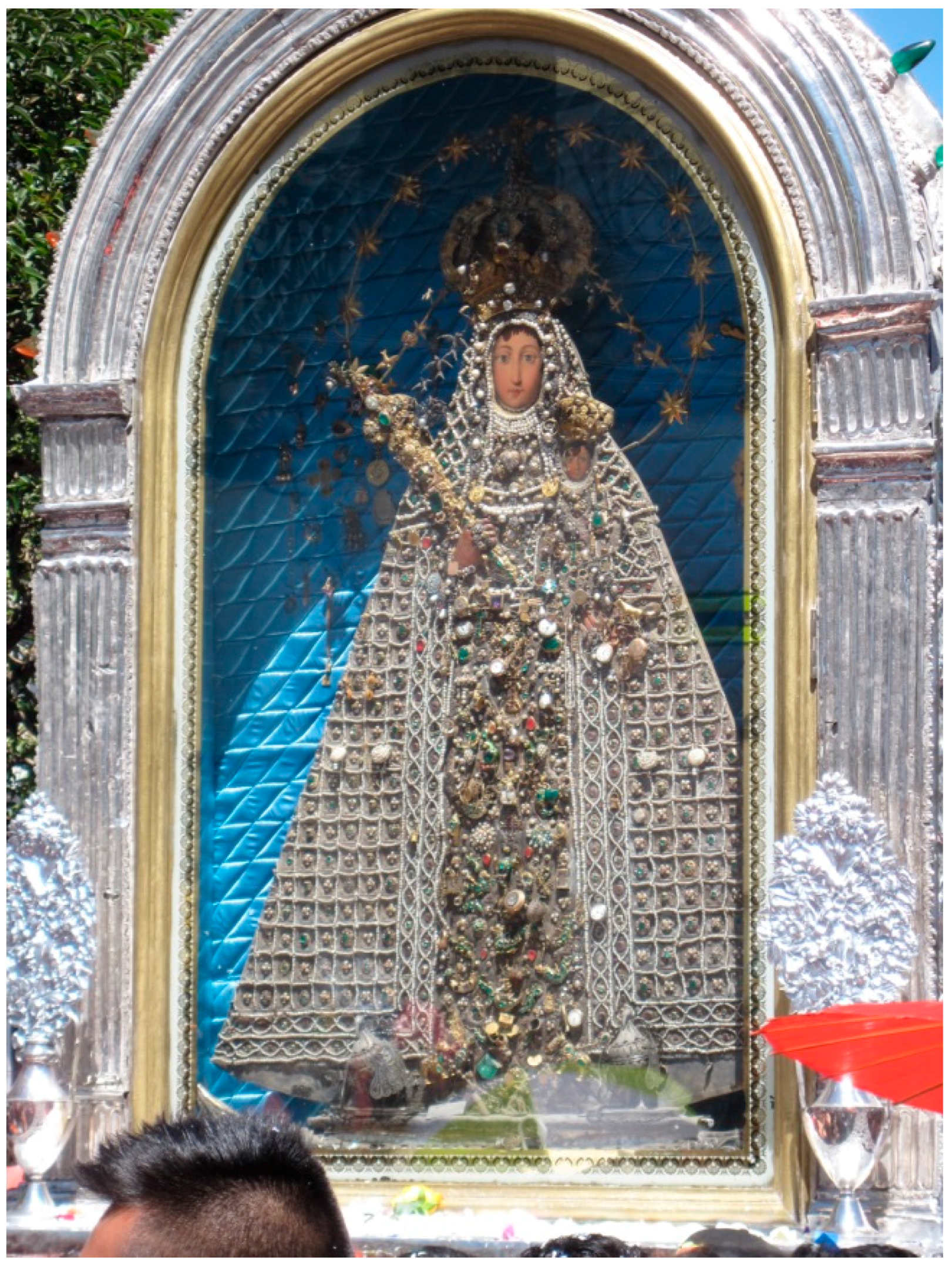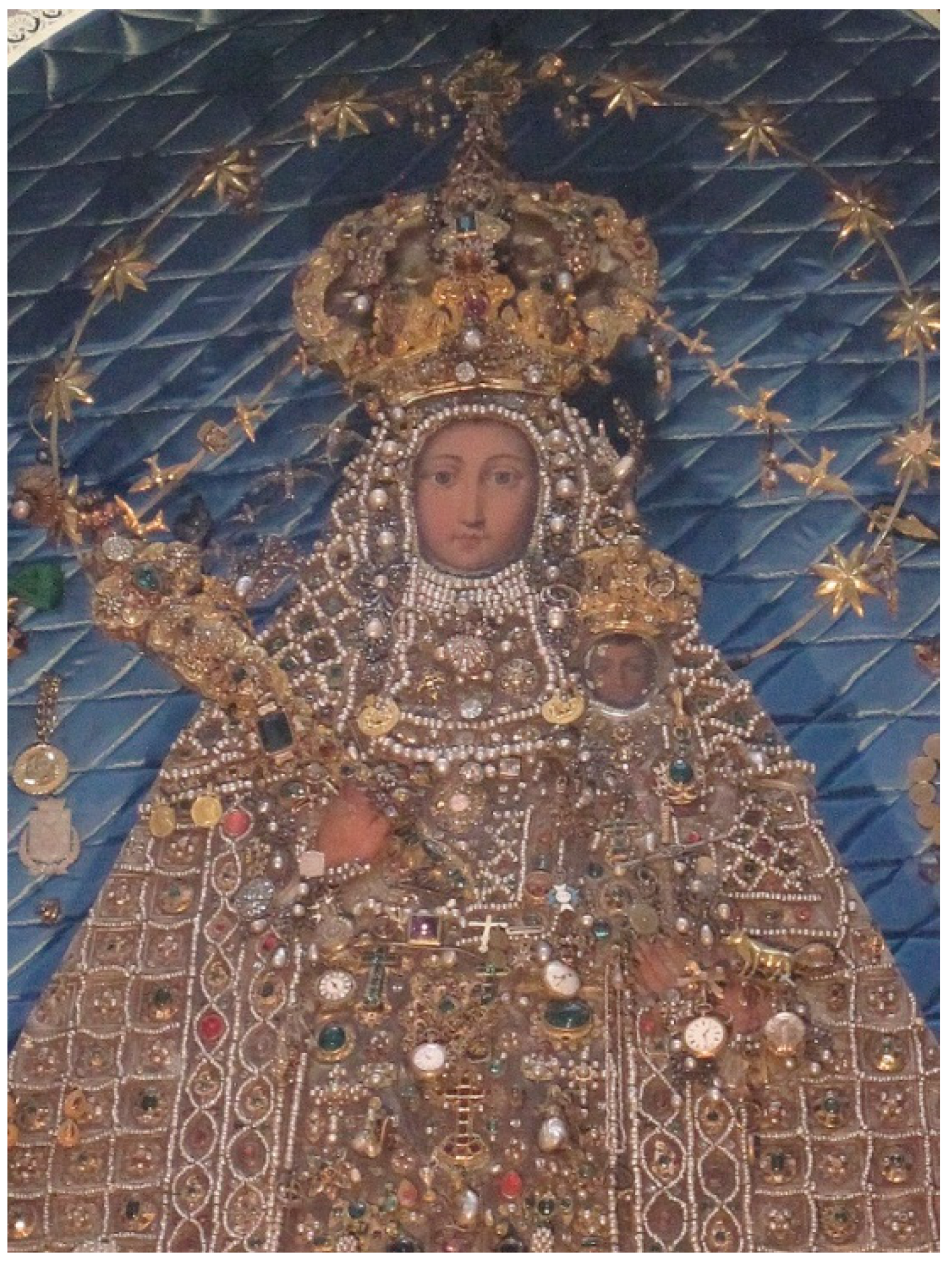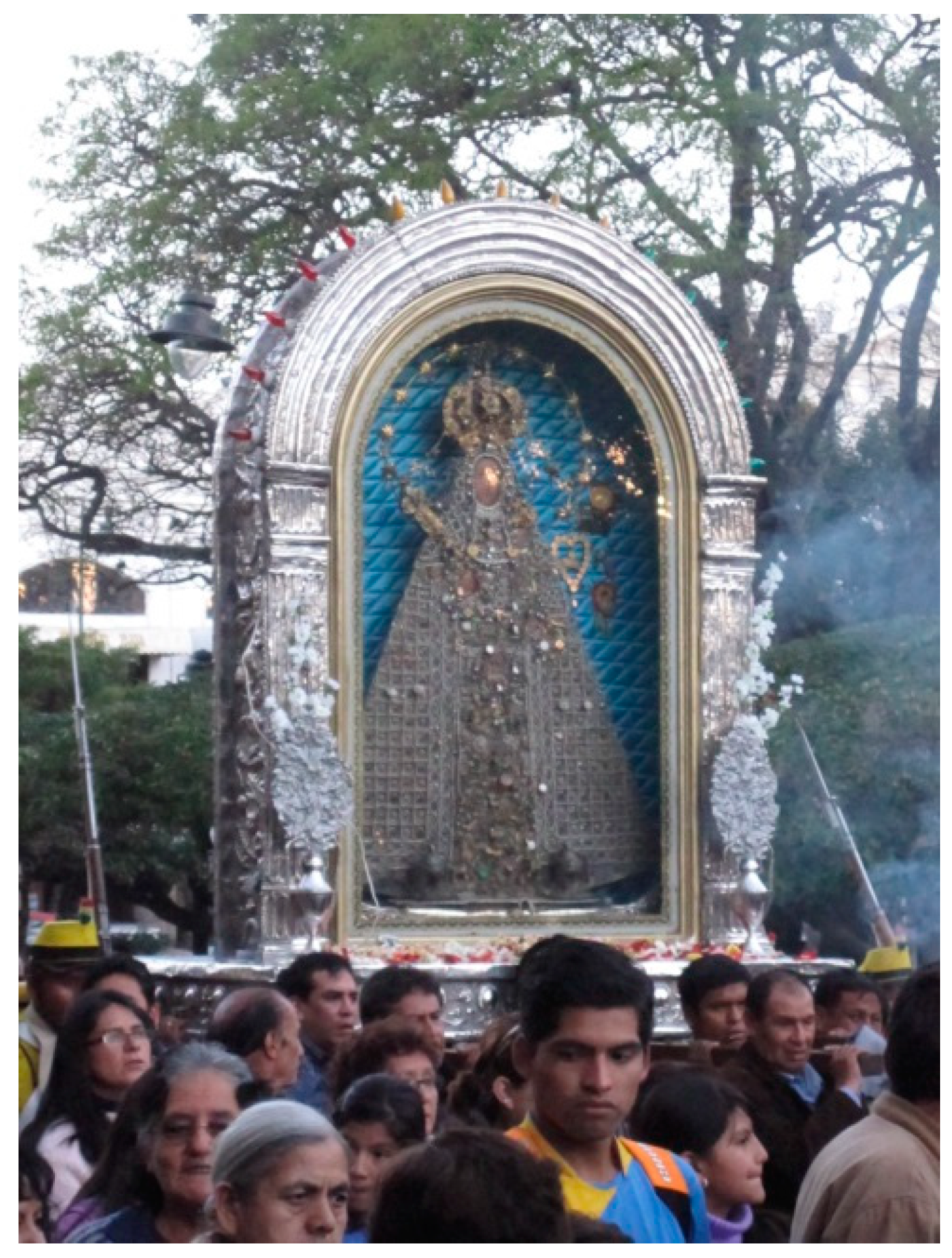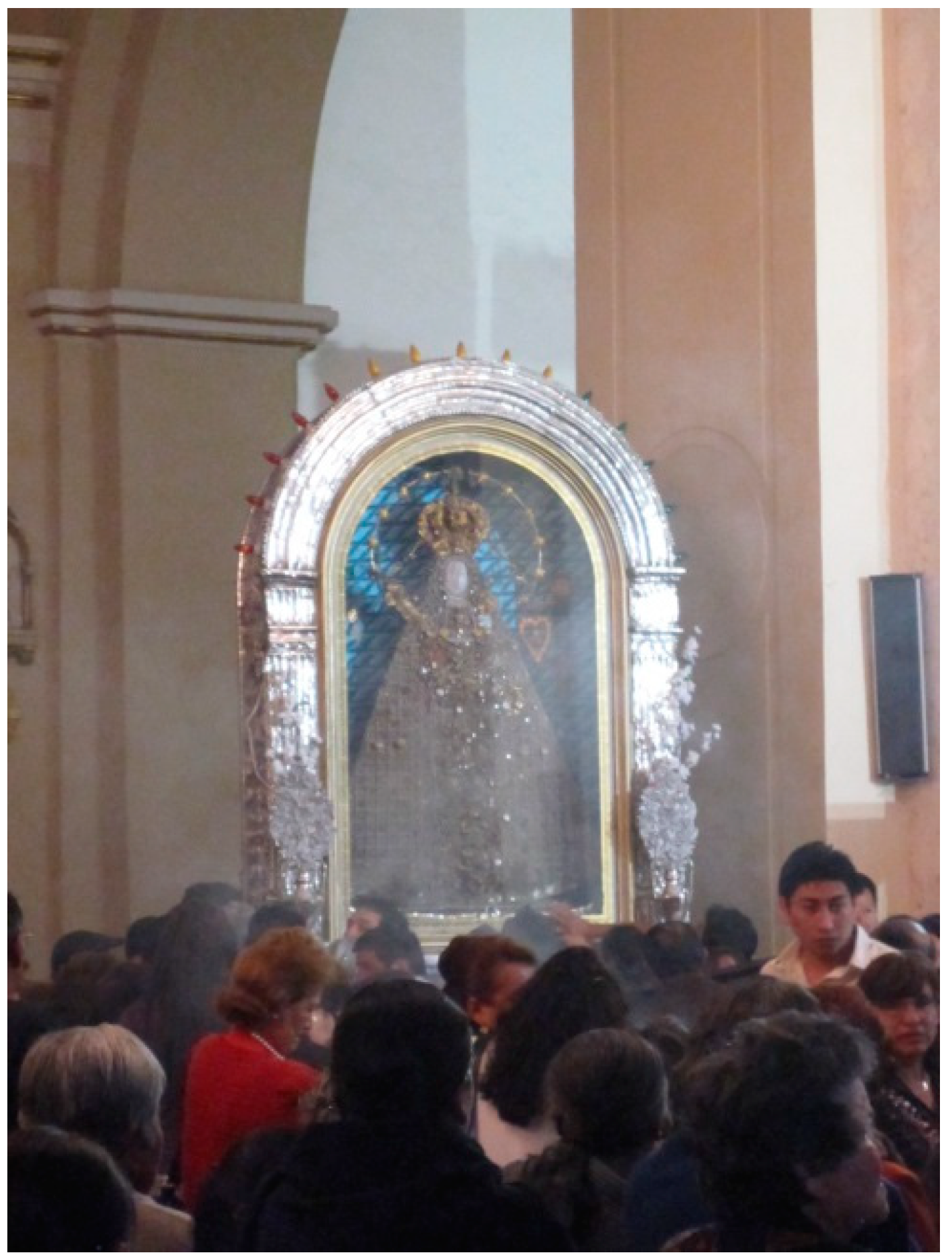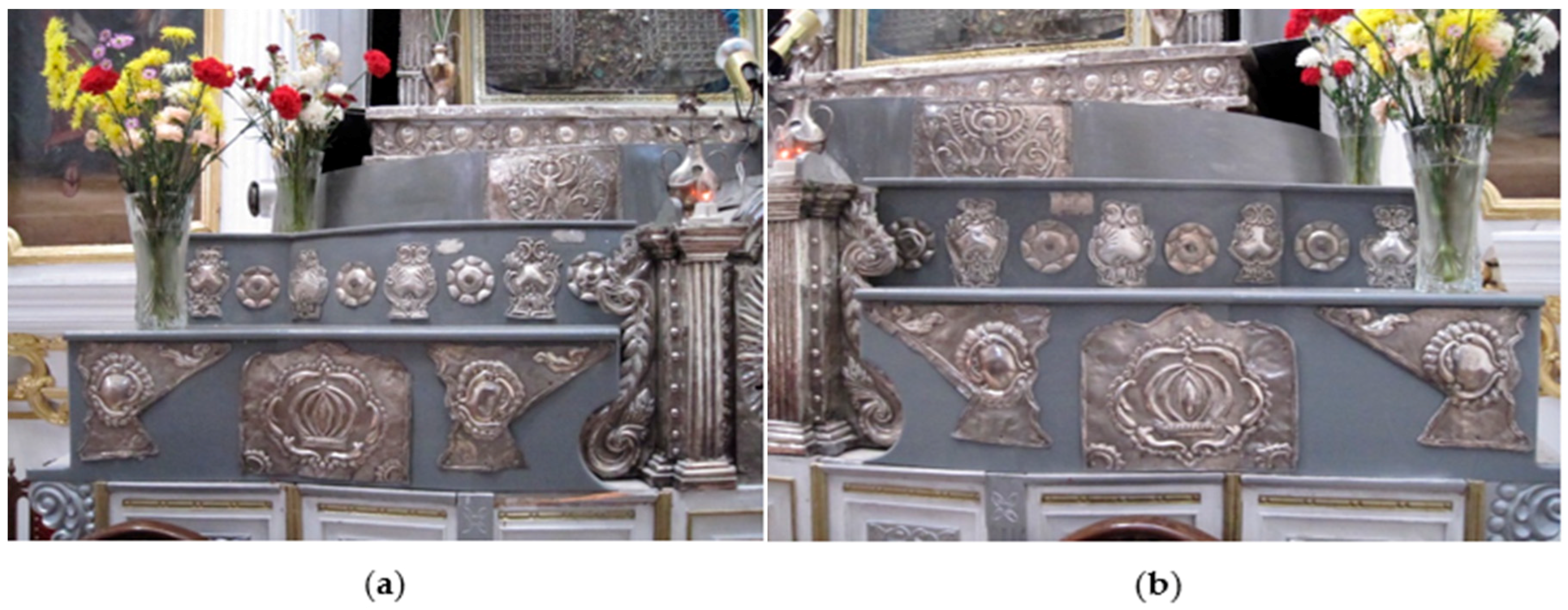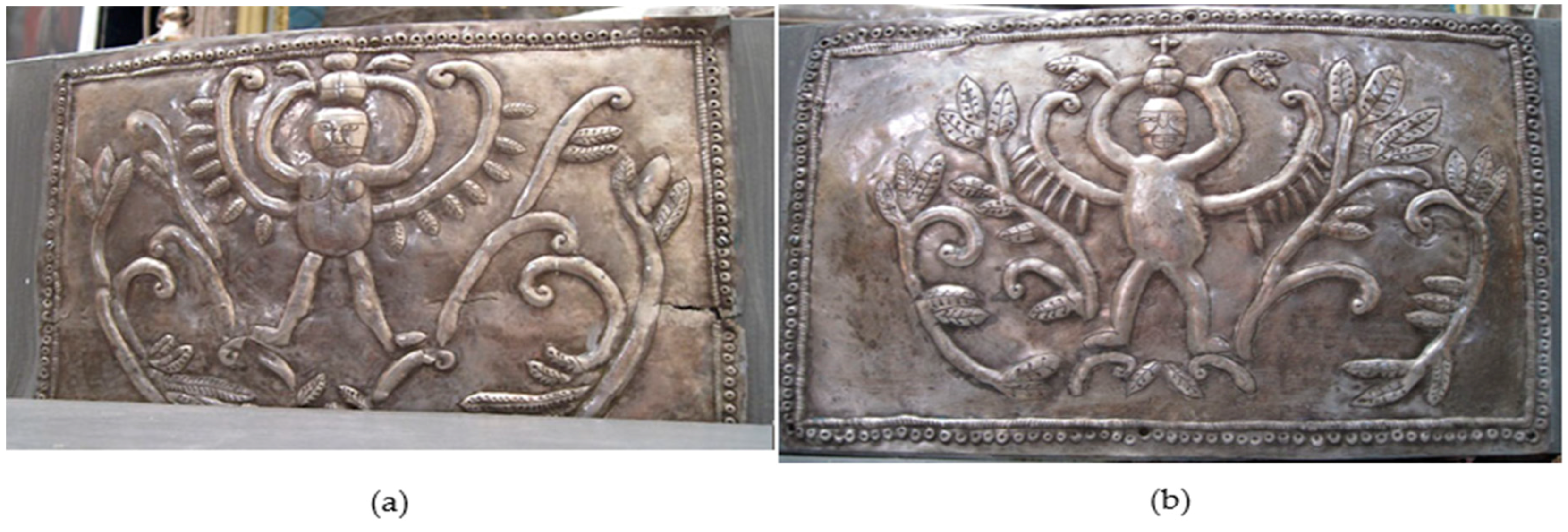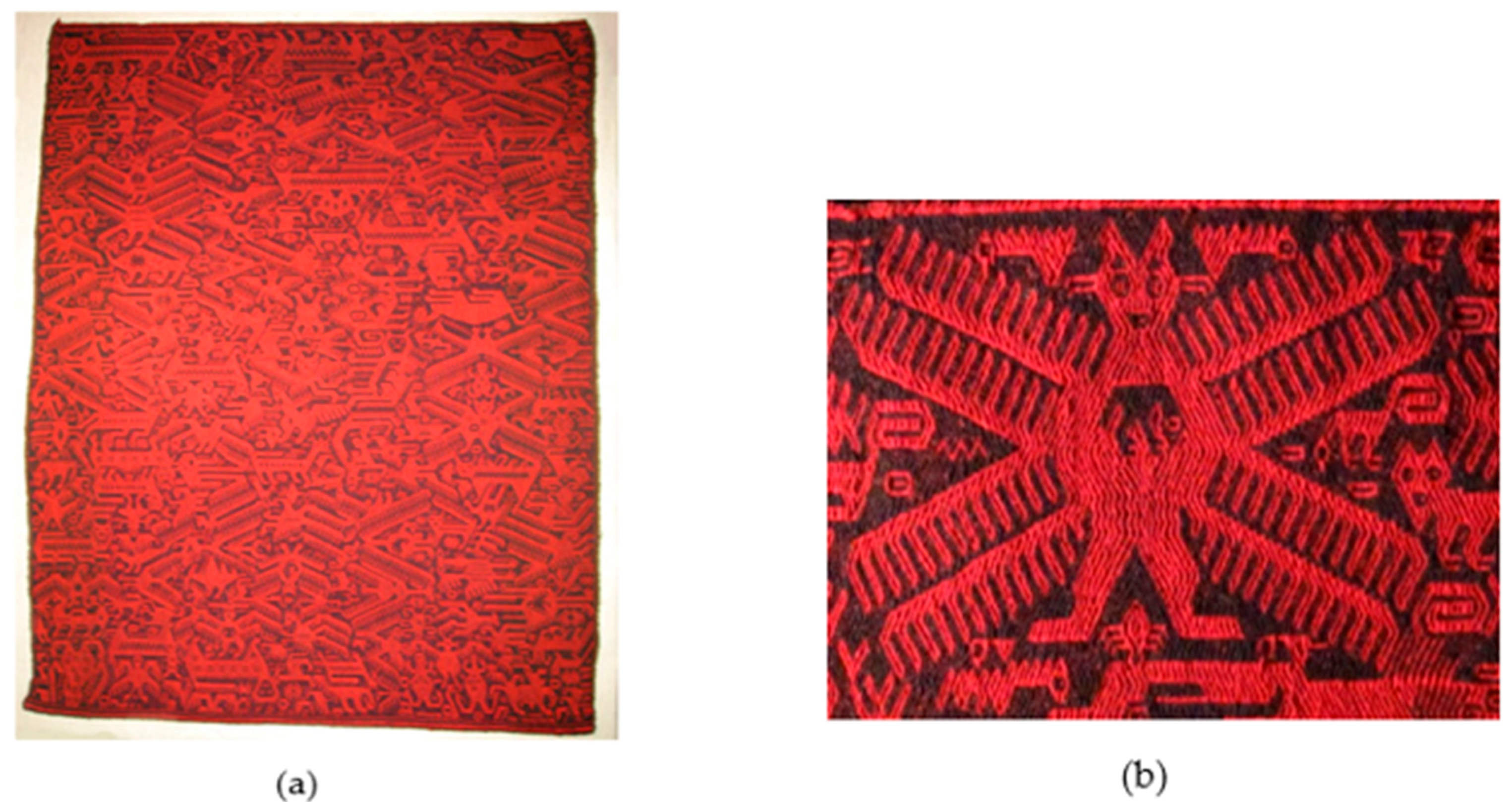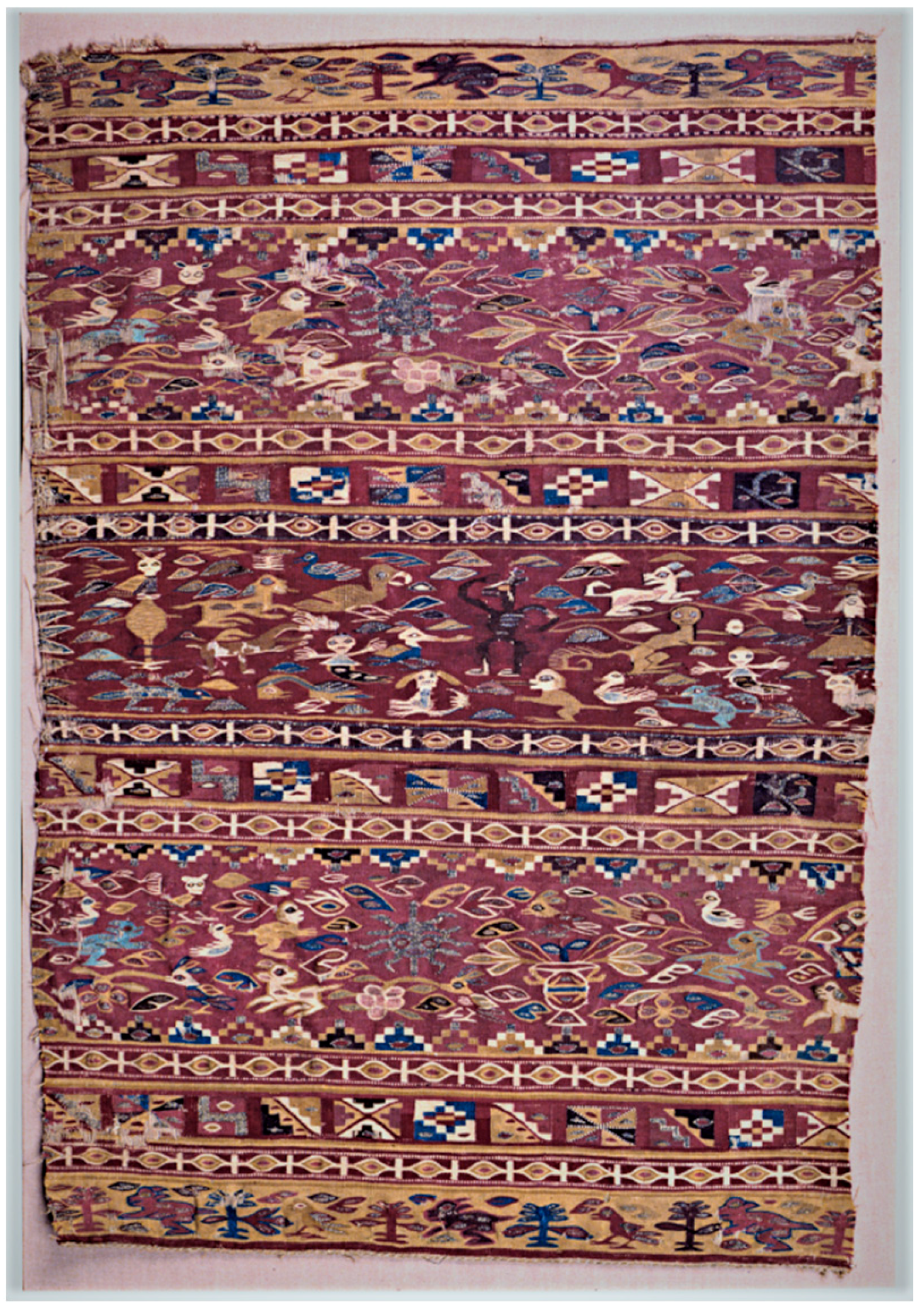1. Introduction
The continuity of pre-Hispanic/indigenous religions has its basis in transcultural processes. These religions are witnessing a powerful renaissance in the context of the current political developments in Bolivia, and can be viewed as the foundation of an emerging new concept of the self.
This article deals with the ways historical actors have used new media—such as ecclesiastical silverworks of the new religious system—to configure new cultural orders and systems of meaning within colonial power relations; another question addressed is whether the ecclesiastical silverworks can be interpreted as media of a transfer of meaning.
The 17th- and 18th-century ecclesiastical silverworks from the Southern Andes region, particularly the antependia and candle banks, are decorated with a multitude of angels, angel-like beings, and birds. Hence, they are well suited for demonstrating the simultaneousness of continuity and discontinuity on the one hand, and for illustrating the concept of multiple interpretations on the other. The focus will be on two winged anthropomorphic beings on the altar of the Virgin of Guadalupe in Sucre (in colonial times also called Charcas, Chuquisaca, and La Plata), Bolivia, in the southern Andes.
3. The Altar of the Virgin of Guadalupe in Sucre, Bolivia
The Virgin of Guadalupe (
Figure 1) is the patron saint of Sucre, the constitutional capital of today’s Bolivia. The original picture of the Virgin was painted in 1601 by the Spaniard Diego de Ocaña, a member of the Hieronymite Order. Ocaña modeled the depiction in his painting on the sculpture of the Black Virgin in the monastery of Santa María de Guadalupe in what is now the Cáceres Province in Spain’s Extremadura region. Worship of the Virgin established itself quickly in 17th-century Sucre, and believers presented her image with countless precious stones, pearls, pieces of jewelry, medals, coins, and small watches to express their veneration. These gifts were attached to the canvas. The votive gifts weighed so heavily on the canvas that the Madonna’s hands, her face, and the face of the divine infant were cut out of the image and set into a cloak-shaped plate of silver and gold. The votive gifts were subsequently transferred onto the cloak too (
Figure 2). In addition, this devotional picture, which is reminiscent of Byzantine icons, was given a so-called throne—a kind of frame. It has a glass front, and its sides and back are made of massive silver.
As early as 1602, a chapel, which has since been the place where the Virgin is worshipped, was added to the cathedral of Sucre.
2 So popular was the Virgin that it became necessary to enlarge the chapel as early as 1617. Mass is held there every day. In colonial times, it was mostly the elites of Sucre who hallowed the Virgin; today, she is widely worshipped by the indigenous population as well.
Every year, nine days before the Virgin Mary’s birthday on September 8, the devotional image is taken from the chapel and carried through the city in a procession, accompanied by secular and church dignitaries and the sound of music and firecrackers (
Figure 3), and eventually reentering the cathedral through the main entrance. The image is then worshipped by the believers until the holiday proper, the day of the Birth of the Blessed Virgin Mary (
Figure 4). On September 8, an open-air mass is held on the Plaza 25 de Mayo. After that, the Virgin is again carried through the city, this time accompanied by a motorcade. The procession temporarily expands the sacred space, and the course of the procession along various buildings of political institutions serves to conjoin and reaffirm worldly and clerical power.
The continuity of pre-Hispanic religious ideas, as well as their association with Christian religious ideas by means of winged anthropomorphic beings, becomes visible on the stairs of the altar of the Virgin of Guadalupe. The candle banks—three wooden steps beneath the devotional image of the Virgin—are decorated with silver plates of various sizes. On two steps, silver elements are mounted to the left and to the right of the tabernacle, respectively; these elements are sides, and possibly also supports and backs, of missal bookstands (Personal communication, Bernardo Gantier SJ, 15 August 2012, Sucre, Bolivia;
Figure 5). The 1799 inventory of the chapel of the Virgin of Guadalupe lists altogether eight missal bookstands, three of which were faced with silver. However, the inventory merely mentions the value of the missal bookstands without giving a description of the depictions on them. It is thus not clear whether the silver parts on the candle banks are one of the bookstands listed. As a consequence, it is not possible to exactly date these plates. Judging from their decoration, however, they were probably made in the 18th century.
The parts of the missal bookstands are attached to the lowermost and uppermost candle banks. The parts on the lowermost step, which are probably support surfaces, show a crown surrounded by a garland, as well as rocaille-like
3 ornaments on the former side parts. Rectangular silver plates are attached to the left and right sides of the third and uppermost steps (
Figure 6).
These are probably the backs of the missal book stands. Each of the two plates features an anthropomorphic figure; these figures are almost identical in their postures: their arms are raised, and they are holding a round object above their heads. Both figures look as if they have wings. The figure on the left side has breasts and is thus probably a woman (
Figure 7a) who, in addition, has an umbilicus. From her wrists emerge two objects that look like snake heads. The figure on the right side has neither secondary sexual characteristics nor an umbilicus. Twigs with leaves on them spring from its raised arms. Like the female figure, it is holding a round object—which has a cross on top—above its head (
Figure 7b). Based on their attributes, their position on the altar, and Christian iconography, the two figures can be interpreted as being Adam and Eve. According to Christian iconography, the figure on the left side would be Eve. Her depiction with breasts and umbilicus is unusual. These features were not usually present, particularly in medieval depictions, as Adam and Eve were created by God and not born as mortal humans. Hence, they often lack both sexual characteristics and an umbilicus. From the Renaissance onward, however, they were depicted with both umbilicus and sexual characteristics (
Poeschel 2005, p. 38;
Menzel 1854, p. 21). The round object above their heads is probably the fruit from the Tree of Knowledge.
According to Christian iconography, the figure on the right side would be Adam. The leaves on his arm may allude to an apocryphal tale: Adam is said to have brought a kernel of the fruit from the Tree of Knowledge with him from Paradise to Earth. When Adam died and was buried, he had that kernel in his mouth. From it grew the tree of which the cross of Christ was made (
Menzel 1854, p. 114). The round object above his head appears to be an imperial orb, a Roman symbol of sovereignty over the world that later became one of the insignia of the Christian rulers.
The Bible says that God had Adam and Eve expelled from Paradise after the Fall. They found themselves in a world where they did not have eternal life; instead, they had to suffer sorrow, pain, and death. By sinning they had destroyed the harmony and peace of nature.
After expulsion from Paradise, Adam and Eve found themselves in a world unknown to them—a disordered world like that with which the indigenous population had to cope after Conquest.
Iconographic analyses reveal the agency of transcultural processes in the images on the objects studied. However, only the combination of various levels of analysis—analysis of historical documents, and inclusion of pre-Christian European and pre-Hispanic contents of images—results in interpretations that would not have been yielded by simple image analysis. This applies particularly to the comparison with possible indigenous meanings of European images, which enables a much more comprehensive interpretation. Depending on the beholder, the images may be interpreted as expressing continuity, i.e., as representations of indigenous beliefs; as expressing discontinuity, i.e., as representations of Christian beliefs; or as the result of a transfer of meaning encompassing and combining both belief systems, thus allowing for a new way of “reading” them. However, they may also be viewed as being purely decorative.
4. Objects of Comparison
Several objects of comparison make the transfer of meaning on the silver plates visible: pre-Hispanic petroglyphs from the Sucre region; a cloak from the colonial era (probably 17th century, Roemer- and Pelizaeus-Museum Hildesheim, inv.-no. V 9.000); and contemporary textiles from the Jalq’a region near Sucre. These modern textiles, which are almost exclusively in red and black, show chaotic scenes (
Figure 8a) referring to the absence of sunlight, the difficulty of seeing things clearly (both in the literal and in the metaphoric sense), and the supernatural world (exhibition text “Tejidos de Jalq’a”, Fundación Antropológos del Surandino, ASUR, Sucre, Bolivia, 2010). One of the most prominent figures represented on the textiles is the so-called
supay (
Figure 8b).
The
supay is a supernatural being associated with the world beyond the human world—that is, with dangerous and disordered (i.e., noncivilized) places. The representations of the
supay on the textiles bear close resemblance to the two figures on the altar of the Virgin of Guadalupe. This type of representation may have developed from pre-Hispanic petroglyphs showing a head with raised arms (exhibition “Tejidos de Jalq’a”, Fundación Antropólogos del Surandino, ASUR, Sucre, Bolivia, 2010). The abovementioned garment, which is probably the wedding cloak of a high-ranking woman (
Phipps et al. 2004, p. 194), shows a creature covered with black hair. With its arms raised and a long snout, it appears among pre-Hispanic- and European-style images (
Figure 9). The textile in the collection of the Roemer- and Pelizaeus-Museum Hildesheim is only one half of the cloak; the other half is in the Textile Museum Washington (Textile Museum Washington D.C. 1968.35.I). The latter features the being covered with black hair, which can be linked to the two figures on the altar of the Virgin of Guadalupe.
The pre-Hispanic
supay ranks among the ambivalent mountain deities of the Andes, and is found in various regions under various names (
Martínez 1983). Still today, the miners regard him as the “Lord of Metals”, whom they need to put into a favorable mind (
Salazar-Soler 1987, p. 197). This establishes a connection between the
supay and the silver plates. In addition, Martínez refers to the mountain deities as double-gendered, “como marido y mujer”, due to their characteristics (
Martínez 1983, p. 98f.). This suggests that Adam and Eve, depicted separately on two matching missal bookstands as well as on the wedding cloak, do not only express that aspect of the
supay but also one of the basic concepts of Andean dualism: the division of the world into masculine and feminine. According to Constance Classen, Adam and Eve are referred to by the Quechua term of
yanantin (“to help each other”); they are two halves that belong together while at the same time containing within themselves elements of the respective other sex (
Classen 1993, p. 13). The indigenous population may thus have interpreted Adam and Eve as the embodiment of a cosmos that, while divided by gender, is essentially one. The representation of the
supay on the wedding cloak from the collection of the Roemer- und Pelizaeus-Museum can be seen in that context, too.
In addition, the positioning of Adam (at the right in depictions) and Eve (at the left in depictions) in Christian iconography is in accordance with the Andean principle associating the male with the right side and the female with the left (
Classen 1993, p. 12).
4 Both indigenous and European beholders could thus interpret the images from the perspective of their respective faith—pre-Hispanic or Christian—, and easily incorporate them into their belief system.
Since the colonial era, the term
supay has largely been used synonymously with “devil” or demons in general. The missionaries tried to transform the ambivalent concept of
supay into an unambiguously Christian concept, so as to establish a contrast between the Christian God and the Andean
supay and other deities and deified ancestors (
MacCormack 1991, p. 257). A translation of the term from the Quechua language is first found in Domingo de Santo Tomás’ 1560 dictionary
Lexicón o vocabulario de la lengua general del Perú. Santo Tomás translates the term into Spanish as “good or bad angel”, “demon or household spirit”, and “good or bad demon”.
5 Hence, his translation clearly alludes to the dual, not exclusively evil nature of the
supay. The dictionary by Antonio Ricardo, published in 1583, gives more translations into Spanish such as “apparition of a ghost” and “shadow of a person”. The lexicon by Diego Gonzalez Holguin also has the translation “apparition of a ghost”, as well as “ghost” and “vision”
(MacCormack 1991, p. 254f.). However, the term is given an exclusively negative connotation in the example sentences included in these dictionaries. That negative meaning was taken for granted by the Jesuit friar José de Acosta as early as 1577. He defined the
supay as the antagonist of God, and the following definition is found in the
Catecismo Mayor of the Third Council of Lima: “[…] chay mana alli Angelcunactam çupay ninchic” (“[…] these evil angels whom we call çupay”) (
Karlovich 2006, n.p.). Inca Garcilaso de la Vega reported in 1609 that the Inca used to distinguish between good and evil, between God and
supay; and Guaman Poma de Ayala refers to the Inca deities in general as
supay who had kept the indigenous population from practicing the Christian faith prior to conquest by the Spaniards (
MacCormack 1991, p. 255). The advanced Christian reinterpretation of the concept of
supay becomes apparent in both these statements.
With the figures of supay Adam and supay Eve, the altar thus features both pre-Hispanic and Christian concepts that reveal a transfer of meaning: a nondominant system can instrumentalize a dominant system unnoticed as a vehicle for its own ideas.
In addition, the existence of the concept of supay, as well as very similar depictions of that being, can be traced from pre-Hispanic times (petroglyphs) to the colonial era (silver plates and textiles V 9.000) and into the 20th century (textiles).
5. Theoretical Approaches
As mentioned above, the
Provincia de Charcas was a colonial contact zone and as such the scene of “transcultural processes”. The underlying term “transculturation” was first introduced by Fernando Ortiz in 1940. Ortiz used the term to characterize the development of Cuban society from the pre-Hispanic era until the modern period. He held the view that “acculturation” was an inadequate term with regard to those historical events, of which European conquest was the most massive encroachment on the existing cultures, as the term merely refers to the process of adaptation of one culture to another (
Ortiz [1940] 1947, p. 97). Bronislaw Malinowski supported that point of view in his preface to Ortiz’s study, as he deemed the concept of acculturation an ethnocentric notion with a pronounced moral connotation. According to Malinowski, that notion implied that “the ‘uncultured’ is to receive the benefits ‘of our culture’; it is he who must change and become converted into ‘one of us’”. Malinowski, in contrast, viewed cultural contacts as “a system of give and take, it is a process in which both parts of the equation are modified, a process from which a new reality emerges, transformed and complex, a reality that is not a mechanical agglomeration of traits, nor even a mosaic, but a new phenomenon, original and independent” (
Malinowski [1940] 1947). Besides the encounter between cultures, the cultural process called “transculturation” includes the deculturation of all populations involved, as well as neoculturation. As defined by Ortiz, deculturation refers to people’s separation from their culture of origin, which applied to all parties involved in the conquest of the Americas: while the Spaniards or Europeans were the dominant power, they found themselves in a completely different world inhabited by people whose languages they could not—and probably did not want to—understand, and by animals and plants unknown to them. The indigenous population,
7 in turn, usually continued to live in its respective region of origin but was forced not merely to arrange itself with European/Christian culture but to make it their own. The black slaves deported from Africa to the Americas were faced with deculturation as well. The next step, neoculturation, is the intentional creation of a new culture. According to Ortiz, such a culture, while having features of its predecessors, is to be viewed as a culture of its own (
Ortiz [1940] 1947, p. 102f.).
The preconditions of transculturation were also found in the Provincia de Charcas in the time period under study. Prompted by transculturation, structures of power and rule were established and negotiated—depending on each party’s room for maneuver—between the Spaniards as the secular conquering power, the Christian church as the religious power, and the indigenous population.
In the sphere of pictorial representation and its perception and interpretation, Margot Berghaus has developed a thesis based on her engagement with Niklas Luhmann’s systems theory, which is applicable to the silverworks studied. Berghaus states that, in contrast to pictorial representations, language is completely defined in social terms; that is, it is socially learned and its use is subject to social control by society. Pictorial representations, in turn, are defined by Berghaus as being “partially extrasocial” (outside social systems,
partiell außersozial) and “partially social” (inside social systems,
partiell sozial) (
Berghaus 2010, p. 179f.). “Partially extrasocial” refers to pictorial representations or parts of images that are decoded by means of cognitive potentials outside the realm of language. These cognitive potentials can take effect regardless of the prerogative of interpretation in a given society, as images defy any complete governing control; hence, they are only subject to partial interpretational control by society. It is possible to understand pictorial representations directly, without “social processes of learning, control, and translation” (
Berghaus 2010, p. 180). “Partially social”, in contrast, are parts of images that can only be understood from the perspective of a specific society. The beholder cannot necessarily grasp the sociocultural meaning of a pictorial representation, what it is supposed to express, and for what purpose it was made (
Berghaus 2010, p. 180). This means that pictorial representations can be partly understood “extrasocially” due to visible resemblance to reality; other elements, however, are incomprehensible, and interpreting them in social terms is a painstaking process (
Berghaus 2010, p. 182).
8The validity of Berghaus’ thesis regarding the partially social and partially extrasocial character of pictorial representations becomes evident in the images on Southern-Andes ecclesiastical silverworks. The representations on antependia, tabernacles, and arches present the beholder with a definitely familiar inventory of images, and the social component of their character reveals itself. However, the setting of the depictions is a foreign cultural context, which renders it much more difficult to decipher their extrasocial component: not only early modern Spanish-European but also indigenous preconditions must be taken into account.
In addition, pictorial representations are associated with very diverse social acts or practices that are inevitably linked to actors, and assign use of the images to a specific purpose (
Kramer and Baumgarten 2009, p. 21). The observations of the actors always go along with making a distinction between “referring to something as this and not as that” (
Berghaus 2010, p. 28). Distinctions are thus decisive for describing reality, and any such description is inevitably constructed by the beholder. This also means that reality is constructed by the beholder, which, in turn, raises the question as to how something has been constructed (
Berghaus 2010, p. 29), as it is the beholder who decides what distinction is made (
Berghaus 2010, p. 46).
In their approaches, Berghaus as well as
Kramer and Baumgarten (
2009), describe what has been called the concept of multiple readings, or interpretations, by Margit Kern. That concept starts from the assumption that, whenever different societies get into contact, one group adopts types of images that have been handed down by the other; it then adapts these to its own realities based on its experiences, horizon of knowledge, and way of thinking, and “reads” and processes them accordingly. It is the beholder who decides on the extent of adopting or combining different visual systems. That is why there exists not only one way of reading the new visual system; there are several ways (
Kern 2010, p. 251). With regard to the ecclesiastical silverworks, this implies questions such as: Do the pictures play a role in church service, and, if yes, is it possible to reconstruct that role? What role is played by which pictures for which strata of the population? What are the various possibilities of interpreting the pictures among the indigenous and Spanish-European populations? As has been mentioned above, the last point in particular raises problems, as there exist no colonial-period records of ways in which images were perceived and interpreted. Iconographies, their contents, and the resulting connections and new possibilities of interpretation are the only feasible approach to these issues.
6. Continuities and Discontinuities
One question arising in the context of studying transfers of meaning in a colonial contact zone relates to cultural continuity or discontinuity that may find expression in the transcultural processes. Cultural continuity is not identical with historical continuity. While both are often viewed as being the same, the latter is actually a characteristic of nationalist and separatist ideologies. It is based, among other things, on Johann Gottfried Herders’ concept of culture, according to which cultures are closed orbs, each with its own spatial and/or linguistic territory.
9 The basic assumption of this concept is that cultures are static entities that do not enter into unions with one another. In my opinion, such a notion has at no time been applicable to cultures, as they are constantly changing and never static. The cultural concept proposed by Herder and others has mainly been employed in constructs of separatist and nationalist ideas that were far from reality. However, it has also played a role in the emergence of nation states in the 19th century. In the present article, cultural continuity is defined as the ability of cultures to change, to adapt to new conditions, to borrow, modify, or discard features of other cultures, and to undergo changes within themselves; however, cultural continuity also relates to the ability of cultures to preserve elements of themselves over long periods of time in spite of adverse circumstances. Defined that way, the notion of cultural continuity implies neither subversion of the conquered vis-à-vis the conquerors, nor agreement with Herder’s concept of culture; it implies the possible continuity and, at the same time, changeability of elements of culture even in a situation of colonial contact.
George Kubler, a renowned expert in ancient American studies, has vehemently spoken out against cultural continuity (
Kubler 1985). According to Kubler, continuity can manifest itself in biological and ecological phenomena; in the sphere of the symbolic, however, there is too much instability to allow for continuity over long periods of time (
Kubler 1967, p. 11). Mainly using architectural features as examples, Kubler maintains that indigenous iconographies were broken down into incoherent fragments in the course of conquest. These fragments lost their content-related meaning even though their origin was, in some cases, still recognizable (
Kubler 1985, p. 68). Kubler claims that while ancient European civilizations, for example, continued to exist in human memory even after their demise, such persistence cannot be found in the Americas. According to him, conquest caused an artificial “lack of culture” onto which the culture of the Spaniards was subsequently implemented (
Kubler 1985, p. 72).
Jeffrey Quilter takes a basically affirmative stance towards cultural continuity, assuming that cultural elements can persist for a very long time in cultures that have supraregional concepts, as is the case in Mesoamerica and South America. In addition, he believes that it is essential to look at everyday culture, as elites are more prone than commoners to adapt to new conditions. However, Quilter argues against a priori assumptions on both continuity and discontinuity (
Quilter 1996, p. 313f). He shows that, in retrospect, historical events may be interpreted as expressions of either cultural continuity or discontinuity, depending on the perspective taken. While Quilter believes that concepts are capable of surviving in societies for centuries or even millennia, he insists on considering both possibilities—continuity and discontinuity—in analyses of transcultural processes (
Quilter 1996, p. 314f).
A similar conclusion is reached by Terence Grieder, who writes that “neither disjunction nor continuity can be safely assumed” (
Grieder 1975, p. 852). According to him, the traditions of cultures include the latter’s practice of expressing themselves by means of symbolism in their material legacy. His ethnological method starts out from the assumption that the symbolic content of a form lives on for a long time in cultures that are characterized by continuity in other spheres as well (
Grieder 1975, p. 649). While Grieder believes that it is impossible to prove anything beyond doubt in this context, he states that it is legitimate to speculate, and he calls upon culture historians to engage in such speculation. According to him, analogy is the best tool, as it allows for conclusions that may reveal, or at least suggest, meanings (
Grieder 1975, p. 853).
With regard to the above example of representations on the silver plates on the altar of the Virgin of Guadalupe, a continuity of the concept of
supay can be assumed from the pre-Hispanic era until the present. At first glance, this appears implausible, given the missionary endeavors of the Spaniards in South America. However, there are arguments supporting the longevity of both iconography and the religious ideas associated with it. Christopher Donnan and Donna McClelland have studied burial rites of Moche culture by means of narrative representations on pottery. They succeeded in establishing a concordance between scenes found on the vessels and shamanic rituals described by Fray Antonio de Calancha in his 1638
Crónica moralizada (
Donnan and McClelland 1979, p. 11f). Given that observation, Donnan and McClelland assume that the contents of the scenes were known from the first century BC until the colonial era (
Donnan and McClelland 1979, p. 12). In addition, Christopher Donnan has studied the motif of bird warriors in Moche iconography. Based on observations he made among modern religious specialists in Peru, he interprets the bird warriors as curers in a state of trance, flying in the air and combating supernatural beings (
Donnan [1976] 1979, pp. 124–43). This suggests the continuity of a religious concept from the time of Moche culture until the present.
In this context, it may be noted that examples of iconographic elements surviving for centuries are found in Europe as well. The early Christian insular manuscripts (from Ireland, northern England, and Scotland), for instance, which date from the seventh to the ninth centuries AD, feature animal and spiral motifs that have their origin in Iron-Age, pre-Christian La Tène culture (
Brown 2003, p. 237;
Netzer 1998, p. 227) that thrived from the fifth century BC until the first century AD.
These manuscripts are also an example of the longevity of pictorial, and particularly religious, representations. In her study of the Lindisfarne Gospels, Michelle P. Brown writes that these manuscripts reflect the ethnic and cultural conglomerate of the region, which includes influences of Celtic, Pict, Germanic, Anglo-Saxon, and Mediterranean art. The latter, in turn, is composed of Roman, Byzantine, Syrian, Armenian, and Coptic traditions. Brown believes that the results of such unions survive for a very long time (
Brown 2003, p. 272f).
7. Conclusions
It is essential, in my opinion, to allow for the possibility of both continuity and discontinuity; in addition, their simultaneous existence needs to be kept in mind in any interpretation of transcultural processes. This line of thought is inherent in the idea of multiple readings, or interpretations, which enables very diverse interpretations—e.g., of pictorial representations—depending on the beholder’s experiences and horizon of knowledge. However, this also means that ideas or pictorial traditions that have been handed down for a long time are just as likely to exist as are new ideas that merge with older concepts into something third.
Depending on the beholder, pictures can be interpreted as expressing cultural continuity (i.e., representations of indigenous belief systems), discontinuity (i.e., representations of Christian concepts), or as the result of a transfer of meaning that includes both belief systems, combines them, and allows for a new interpretation. Any solid assessment of the way representations were perceived would require surviving records that, however, do not exist. The only viable approach is to base such an assessment on as much information as possible. In the present article, this information pertained to the respective iconographies of the Christian-Spanish and pre-Hispanic indigenous cultures, as well as to the way the objects were historically integrated in their social contexts. This results in a new interpretation of supposedly known picture contents.
In my opinion, the question of whether the transcultural transfer of meaning actually generates something new or whether there is merely a transfer of content is difficult to answer. Cultures are nonstatic entities that are constantly changing; at the same time, however, they pass down elements and contents over long periods of time, locating them in changing contexts of meaning. This means that cultural continuity and discontinuity are always parallel processes, and that not everything that seems to be new is actually new. On the other hand, seemingly traditional elements can turn out to be new, as new meanings are attributed to them over time. In addition, another fact needs to be considered: depending on the beholder, either the “indigenous eye” or the “European eye” is blind when it comes to analyzing iconography. This results in one-sided interpretations. This (in)visibility and (dis)continuity needs to be taken into account in analyses so as to get a historical reconstruction that is as accurate as possible, and to avoid essentialization.
10 If the analysis is based on written sources, different perspectives on reality are taken by the various texts on a given event (or rather by their authors) and the researcher. In the case of pictorial representations on which there exist (as in the present study) no interpretative texts, the researcher needs to describe and interpret from all possible perspectives.
